Plantar fasciosis is a condition that affects the plantar fascia of the foot on the attachment site. The plantar fascia is a band of tissue that runs along the bottom of your foot and attaches to your heel bone. The plantar fascia is located between the bones of the mid-foot and helps you walk by providing support when pushing off with your toes.
Plantar fasciosis is also known as calcaneal enthesopathy or calcaneal spur syndrome in medical societies and can involve stretching, tear and degeneration of the plantar fascia at the point where it is attached to the heel.
Syndromes that affect the plantar fascia and cause pain are usually called plantar fasciitis. However, plantar fasciitis is only the medical correct expression when the plantar fascia shows signs of inflammation. But in most cases, there is no inflammation and therefore plantar fasciosis is the correct term.
Symptoms and signs of plantar fasciosis
Despite the difference between plantar fasciosis and plantar fasciitis, the symptoms and signs are very similar for both conditions. You might have plantar fasciosis if you:
- Have pain in your heels. Pain under the heel when putting weight on it is a classical symptom for plantar fasciosis or plantar fasciitis.
- Experience pain early in the morning. In most cases, pain shows up immediately after getting up after the first few steps in the morning. In some cases, the pain is there to stay and in other cases, it vanishes after 10-15 minutes, only to come back later in the day.
- Recognize swelling or redness. This is not very common but can occur in more severe cases.
- Have difficulty standing on your toes. Pain in the plantar fascia can make it difficult and painful to stand on your toes or stretch them towards the ceiling.
- Feel pain when walking or standing. This is a general symptom that can be caused by other conditions as well.
- Have a heel that is sensitive to the touch. This symptom is an indicator of plantar fasciosis, plantar fasciitis or heel spurs.
What can cause plantar fasciosis
The number one cause for plantar fasciosis is too much pressure, weight and stress on your feet. Certain professions, sports and hobbies have a huge effect. In general, men and women between 40-70 have an advanced risk to develop plantar fasciosis, especially if they’re very active. That comes as a combination of the high impact of certain activities and the already beginning degeneration process of the plantar fascia. Professional athletes frequently suffer from this condition. Tom Brady, for example, had it for months and wasn’t performing at his peak because of this. Causes of plantar fasciosis include:
- Too much weight and stress on the plantar fascia ligaments.
- Walking or running on hard surfaces, like concrete.
- Repeatedly jumping on a hard surface, as in basketball or volleyball.
- Foot deformities, such as having high arches or flat feet.
- Being overweight.
- Inappropriate footwear that restricts blood flow to the bottom of your feet.
- A pregnancy that causes more weight and stress to your feet.
- Shortened calf muscles.
- Certain types of arthritis, such as rheumatoid arthritis, reactive arthritis or psoriatic arthritis

Diagnosis of plantar fasciosis
Diagnosing plantar fasciosis always begins with an exam. Your doctor will ask you about your symptoms, when the symptoms first occurred, the type of pain and your overall lifestyle to get a sense of your situation.
The first sign of plantar fasciosis is when firm thumb pressure applied to the calcaneus (heel bone) when your foot is bend upwards elicits pain. You may feel pain along the plantar fascia as well.
X-rays can rule out other conditions such as heel spurs, arthritis, or spondyloarthropathy. If an acute tear of the plantar fascia is suspected, your doctor will recommend MRI to confirm the diagnosis.
Treatment of plantar fasciosis
Treatment of plantar fasciosis usually starts with conservative methods. The R.I.C.E method is generally a good start. R.I.C.E stands for:
- Rest
- Ice
- Compression
- Elevation
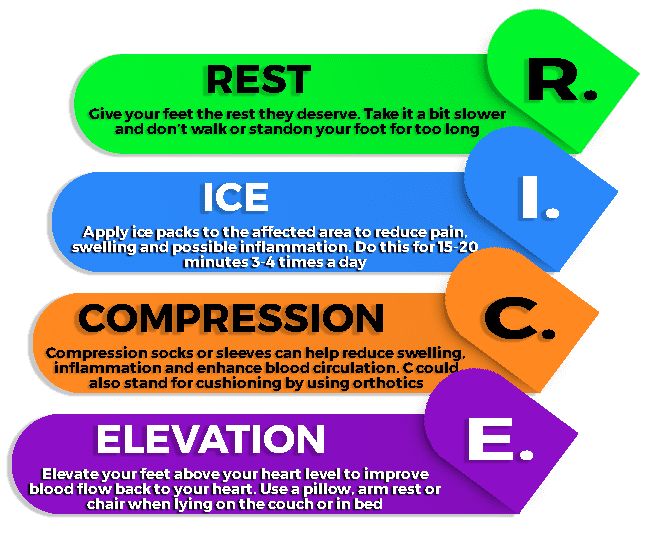
We’ll come back to this method later when we talk about home remedies.
Therapy has two aspects, pain management and recovery. The recovery process can only start if you can bear a certain level of pain, that’s why you need to reduce your pain to get started. NSAIDs like Ibuprofen or Aspirin work really well in relieving acute pain. If those over-the-counter medications are not enough, you may need to consult your doctor for prescription medications that have higher doses.
It is critical to avoid the activities that caused the condition during your recovery time. Give your feet the rest they need. Don’t walk or stand too long, don’t exercise too much, especially with weights that put more pressure on your feet. Skip running or jogging for a few days or weeks and avoid walking barefoot.
Massage therapy is also a good method to reduce pain. By loosening the tension of your muscles and ligaments in your foot, the plantar fascia can relax. You can self-massage your plantar fascia at home with a bottle, massage ball or massage device as well.
Night splints, compression sleeves, a boot or cast to immobilize movement are highly recommended by physical therapists, podiatrists and surgeons. So make sure to get a few pairs of good compression socks and a night splint for faster recovery. We have some really good products on our store that have helped thousands of customers from all around the world treat various foot conditions. So feel free to have a look.
Physical therapy is the next step. Stretching, range of motion, strengthening and balance exercises will do the trick. In most cases, physical therapy does wonders to treat plantar fasciosis effectively.
A fairly new method to treat plantar fasciosis is extracorporeal pulse activation therapy (EPAT). Low-frequency pulse waves stimulate metabolism and enhance blood circulation. And that helps regenerate damaged tissue and speeds up the healing process.
Surgery is often considered the last resort for people that are not responding well to conservative treatments. A surgeon can remove the damaged tissue in your foot or release the plantar fascia.
Home remedies for plantar fasciosis and lifestyle changes
This section is the most important part of the whole article. We have discovered symptoms, causes and medical treatments so far. But once the damage is done, you need to change your lifestyle, now and maybe forever.
There are a few home remedies that can help reduce the pain and inflammation associated with plantar fasciosis or plantar fasciitis. We’ll go over them below:
The R.I.C.E method is very effective in treating plantar fasciitis and plantar fasciosis alike. Give your feet some rest. Reduce your activity level. Don’t stay on your feet for too long, don’t walk barefoot and avoid running or jogging until the pain goes away completely. If you can’t walk barefoot because it hurts too much, you’ll need to wear good supportive shoes that won’t put pressure on the plantar fascia. Proper heel cushioning is one of the most effective strategies you can apply. We have seen awesome results with our heel seats and memory foam insoles. Finding good shock-absorbing orthotics is absolutely key for you in this situation and one of the first investments you need to make.
To reduce inflammation or swelling apply ice packs on the affected area for 15-20 minutes and do this 3 to four times a day. Don’t put the ice directly on your skin. Wrap the packs in a towel or piece of cloth first.

Our plantar fasciitis compression socks and sleeves will do a great job in helping you heal faster. These products are not only good for pain relief, but the increased blood circulation helps treat inflammation and swelling as well. That is the compression part of the R.I.C.E method. So be sure to get yourself a good pair of compression socks or sleeves.
Elevation is the fourth and last part of this method. Place your foot above your heart level to enhance the blood flow back to your heart and reduce swelling. You can use a pillow, ottoman or any elevated surface. Do this whenever you can, for example when watching TV on the couch or during the night.
Braces and supports for plantar fasciosis
Night splints are a great way to keep a healthy stretch overnight. Night splints for plantar fasciosis hold your foot in a flexed position and provide a good stretch to the plantar fascia and Achilles tendon. With a night splint, you can avoid morning pain and stiffness and start into the day fresh and rested. To maintain good support throughout the day, we recommend putting on compression socks immediately after waking up, even before getting out of bed.
Orthotics that support your arch distribute pressure and take away a lot of the pain. Besides this, they prevent further damage to the heel and plantar fascia.
Choosing the right shoes
Proper footwear is one of the easiest, but most important things that you can do on your own to ease the pain and prevent plantar fasciosis from striking time and time again.
Inappropriate footwear is the number one cause of plantar fasciosis. Shoes that force your toes, especially the big toe, into an awkward, adducted and extended position restrict blood flow through the posterior tibial artery that carries blood to the bottom of your feet. The tissue in the sole of your feet begins to degenerate and show signs of tear over time.
Finding and wearing shoes that keep your feet in their anatomically correct position is the best treatment and should be your goal from now on. You should look for shoes that have a wider toe box and lack toe spring. Flexible soles and heel cushioning are a plus to have as well.
Pro Tip: If you have shoes that you would like to keep and wear, though they might cause problems, you can widen the toe box by stretching the shoe’s upper and toe spring. Cutting the shoe at certain key points can do wonders for you. A professional and good cobbler will assist you and can adjust your shoes to your personal preferences.
Keep your weight in check and stretch daily
We all carry those extra pounds with us. And as we get older, it becomes more and more difficult to lose them. I feel you. But you need to keep your weight in check, especially if you’re already overweight. And if you need to lose a pound or two, choose a diet that suits you best and try to mix it with some cardio exercises.
Daily stretches of your feet, ankles, and calves should get a fixed appointment in your schedule. There are various good exercises that you can take. Please have a look at our other articles about plantar fasciitis and foot pain in general to find ideas for stretches. Here are the 3 best stretches and self-massage techniques you can try:
1) Wall stretch: Place your affected foot against the wall and lean into it, keeping your heel on the ground. You should feel a good stretch in the calf and Achilles tendon. Hold for 30 seconds.
2) Towel stretch: Put a towel on the floor and step onto it with your affected foot. Slowly pull in the ends of the towel to increase the tension in your ankle. Hold for 30 seconds, relax and repeat three times in each direction (upward/downward).
3) Tennis ball massage: Place a tennis ball under your foot and ankle and press down. Roll the ball around with your foot. You will feel a good stretch in the sole of your foot.
The tennis ball massage is just a basic version. You can replace the tennis ball with a bottle that you put into the freezer first. That will be one of the most relieving stretches you can get. Trust me, this tip alone will save you a lot of pain.
Takeaways
Plantar fasciosis is generally not a good diagnosis. But there’s hope and there are a lot of exercises, stretches and therapies that can and will get you out of it. I have gone through this hell myself two years back, so I know what I am talking about. Don’t lose faith. Give your body the time and rest that it needs and work your way back into life – step by step.
I would love to hear your thoughts and opinions about this article, tips and tricks that helped you with your conditions and, of course, your full stories. So please comment below and share your thoughts with our readers.




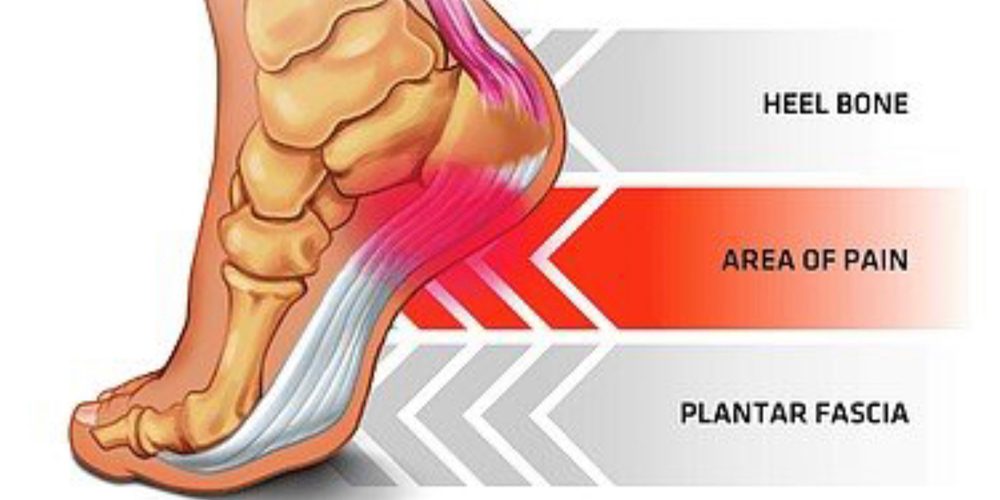




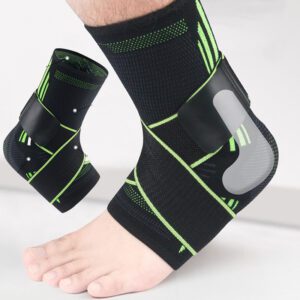


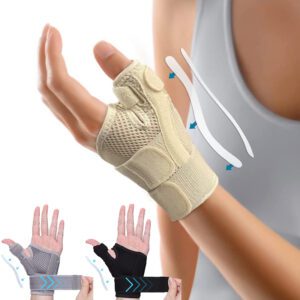


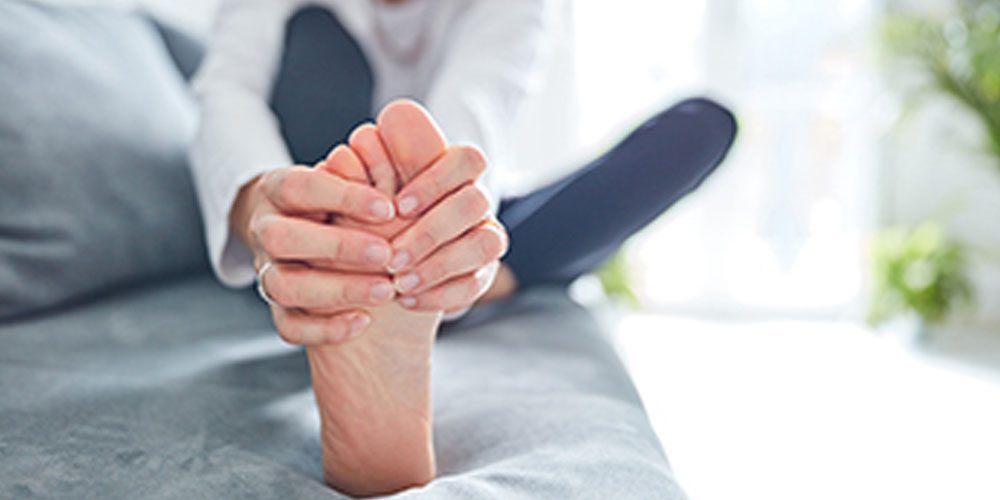





7 Responses
I’m 67 years old and I still skateboard 🛹. I just started feeling a lot of pain in my left ankle. It’s exactly the same as you describe on your article. I also push with my left leg.
Thank you for the information. Seeing my doctor tomorrow first thing!
I have intense burning in my heels it seems to be getting worse.
I am not diabetic in the slightest. My doc says it could be acidity. Am at my wits end. I must find out what could be causing it
Thank you for the info. I had 2 surgeries on right foot this year and left needing surgery next. I tried to avoid surgery with all the methods. I’m wanting to try shockwave therapy and more physical therapy asap to heel surgical foot and hope to heal other foot. 😭 🙏
I had no idea that plantar fasciitis is a condition that affects your heels. I heard that my aunt is having a hard time doing her usual jogging routine lately because of pain. I think she should consider finding a podiatrist that can take a look at her foot in the future.
Well it’s my friend who is 80 and her only sport is golf,.it’s early days yet ,.my Doctor told me about the Golf ball but the pain is too much for me,.il try ur tips and hope for the best
I have been to 3 doctors, taken antibiotics and various other, tried medicated plasters, sprays and ever thing recommended. The intense burning has gone so i guess the inflammation is gone but the pain remains. I have ordered the socks now so let’s see if this helps. Guess I will have to live with this.
I am in pain all day! It’s terrible!